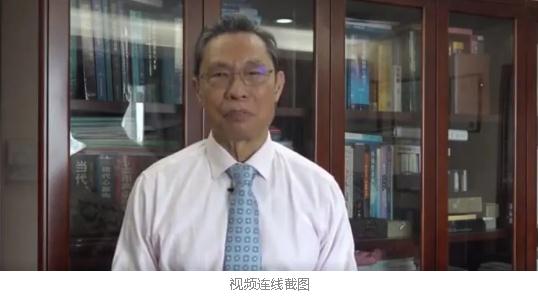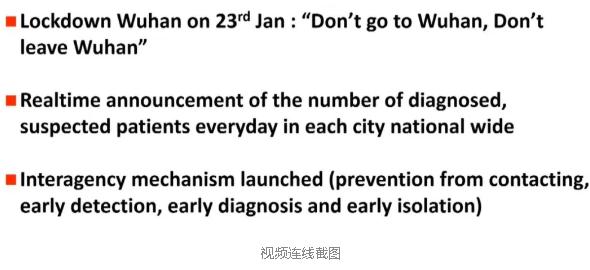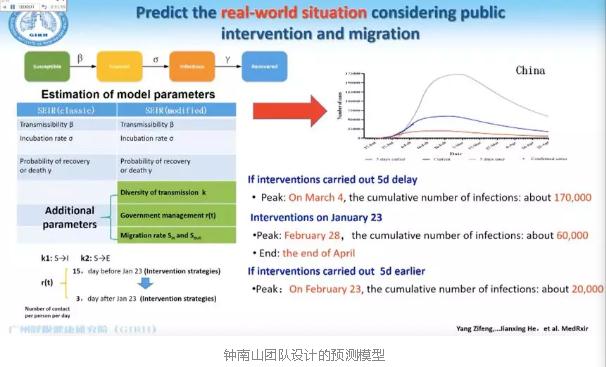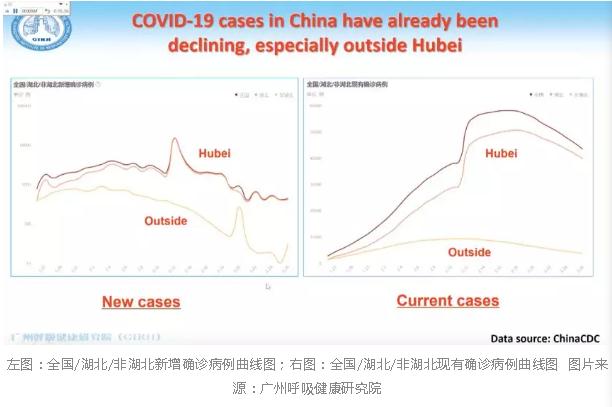全程英语!钟南山连线欧洲同行,分享中国经验
中国日报双语新闻微信 2020-03-15 09:00

3月3日至4日,国家卫健委高级别专家组组长、中国工程院院士钟南山与欧洲呼吸学会(European Respiratory Society)候任主席安妮塔·西蒙斯博士(Anita Simonds)进行了视频连线,向欧洲呼吸学会介绍与分享了中国抗击新冠肺炎疫情的成果和经验。
西蒙斯博士询问钟南山,为什么武汉建造方舱医院转移轻症患者,而不是让他们居家隔离。
钟南山说,疫情早期,很多感染新冠肺炎的人群都呆在家里,导致家人被传染。所以首要任务是将大量感染者与健康人群隔离开。
The priority was to separate and to distinguish the infected people from healthy people. So we set up simple hospitals or wards and asked them to stay there. That's where those huge number of patients can go.
西蒙斯博士还询问了武汉封城的效果,她说虽然意大利也封城了,但欧洲大城市要采取这样的措施很难。
钟南山说,在没有特效药的情况下,封城是控制疫情蔓延的最古老也是最有效的办法:
I suppose that's the only way because we don't have a targeted medication. It's a new virus, so probably that's the oldest and the most efficient way to prevent it from further spreading.

在视频连线中,钟南山做了题为“中国对SARS冠状病毒2(COVID-19)感染的处理观点”的演讲。

其中,钟南山介绍了中国控制疫情扩散的措施:

第一步、1月23日武汉封城,“不要去武汉,不要离开武汉”。
第二步、实时发布(real-time announcement)全国每个城市每天的确诊或疑似患者人数。
第三步、启动跨机构机制(interagency mechanism)。这意味着大规模预防接触和自我隔离,及早发现、早期诊断、尽早隔离(early detection, early diagnosis and early isolation)。
钟南山提出,很多研究团队公布的预测模型并没有纳入“政府及时干预”等参数,因此预测结果并不准确。
The predictions made by overseas scholars haven't taken into account the strict control measures in China, which led to possibly exaggerated research results, respiratory scientist Zhong Nanshan said.
钟南山所在团队此前设计的预测模型(模型使用的数据截至2月9日)纳入了更全面的参数,包括国家强力干预、春节后回流高峰消除等。

模型的预测结果显示,国内疫情将在2月下旬达到高峰,4月底得到基本控制。
目前,疫情流行数据均在该模型的预测范围内。
The outbreak of novel coronavirus pneumonia in China peaked in late February and will level off in late April, the research headed by Zhong Nanshan predicted.
Until now, the real data are within the prediction range and are closer to the real situation, he said.
钟南山称,全国、特别是湖北以外地区的确诊病例数已经在下降。

钟南山表示,一些欧洲国家陆续出现了疫情暴发,应当尽早防止扩散。他指出,必须通过检测区分出新冠肺炎和流感,中国愿意把自己的经验分享出去,与欧洲呼吸学会互通有无。

编辑:左卓
来源:央视新闻、澎湃新闻、中国日报

















 英语点津微信
英语点津微信 双语小程序
双语小程序